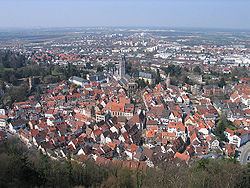Admin. region Karlsruhe Elevation 135 m (443 ft) Local time Sunday 11:47 PM | District Rhein-Neckar-Kreis Time zone CET/CEST (UTC+1/+2) Population 43,651 (31 Dec 2008) | |
 | ||
Weather 13°C, Wind E at 6 km/h, 56% Humidity | ||
Day 3 german christmas markets weinheim
Weinheim is a town in the north west of the state of Baden-Württemberg in Germany with 43,000 inhabitants, approximately 15 km (9 mi) north of Heidelberg and 10 km (6 mi) northeast of Mannheim. Together with these cities, it makes up the Rhine-Neckar triangle. It has the nickname "Zwei-Burgen-Stadt", or Two-Castle city ('Burg' means 'fortress'), named after the two fortresses on the hill overlooking the town in the east on the edge of the Odenwald, the Windeck and the Wachenburg. The city of Weinheim with said Wachenburg castle, built by German Student Corps fraternities in the early 1900s, is the location of the annual convention of the Weinheimer Senioren-Convent.
Contents
- Day 3 german christmas markets weinheim
- Map of Weinheim Germany
- Geography
- History
- Local attractions
- Museum
- Events
- Local businesses
- Trains
- Air
- International relations
- Population over time
- Honorary citizens
- Sons and daughters of the town
- People who worked in the town
- Government
- References
Map of Weinheim, Germany
Geography
Weinheim is situated on the Bergstraße theme route on the western rim of the Odenwald. The old town lies in the valley, with the new part of town further to the west. The Market Square is filled with numerous cafes, as well as the old Rathaus (guildhall). Further to the south is the Schlossgarten (Palace Garden) and the Exotenwald (Exotic Forest), which contains species of trees imported from around the world, but mostly from North America and Japan.
History
Weinheim celebrated its 1250th anniversary in 2005.
The earliest record of Weinheim dates back to 755 AD, when the name "Winenheim" was recorded in the Lorsch codex, the record book of Lorsch Abbey.
In 1000 AD, Emperor Otto III bestowed Weinheim the right to hold markets, and in 1065 the right to mint and issue coins. A new town developed next to the old town from 1250. In 1308, the old town was transferred to the Electorate of the Palatinate. From 1368 onwards the whole town belonged to the Electorate of the Palatinate and the Heidelberg Oberamt district since the end of the 14th century. With the transfer to Baden in 1803, Weinheim became the seat of its own Amt, which was unified with Landkreis Mannheim in 1936. From 1938 onwards Weinheim belonged to Landkreis Mannheim until January 1, 1973, when the Rhein-Neckar-Kreis was formed.
Local attractions
Museum
Weinheim's town museum occupies what used to be the headquarters of the Teutonic Order in the town and holds exhibits about Weinheim and its surroundings: archaeology from the prehistoric through to the Merovingian dynasty, the highlight of which is the so-called "Nächstenbacher Bronze-find" of 76 objects from the late Bronze Age; displays documenting the Medieval and modern social history of the town and works from contemporary artists.
Events
Local businesses
Trains
Weinheim has two main train stations on the Main-Neckar Railway, these being Weinheim (Bergstraße) station (served by Regional and long-distance IC trains) and Lützelsachsen (served by Regional trains). These provide connections to Frankfurt, Hamburg and other destinations within Germany.
Weinheim is also served by the OEG tramway, which is used daily by people who use this to commute to the cities of Mannheim and Heidelberg.
Air
The closest airports to Weinheim are:
International relations
Weinheim is twinned with:
Population over time
These are the population figures for particular years. There are drawn from guesses, 'Volkszählungsergebnisse (semi-official figures, demarcated by a ¹) and official statistics based on place of residence (Hauptwohnsitz).
¹ These are taken from a Volkszählungsergebnes.
Honorary citizens
The town of Weinheim has made the following people honorary citizens (Ehrenbürger):
